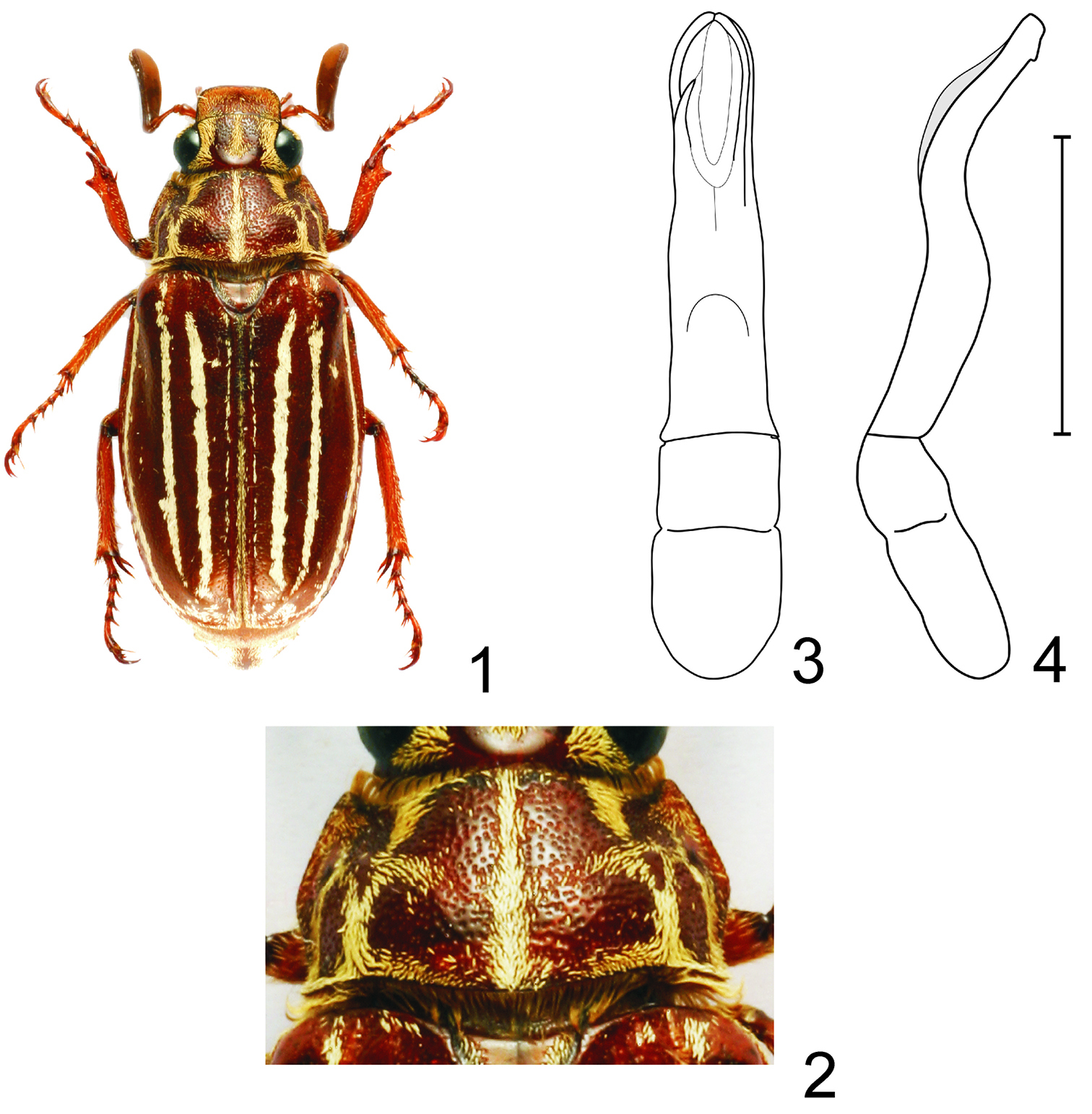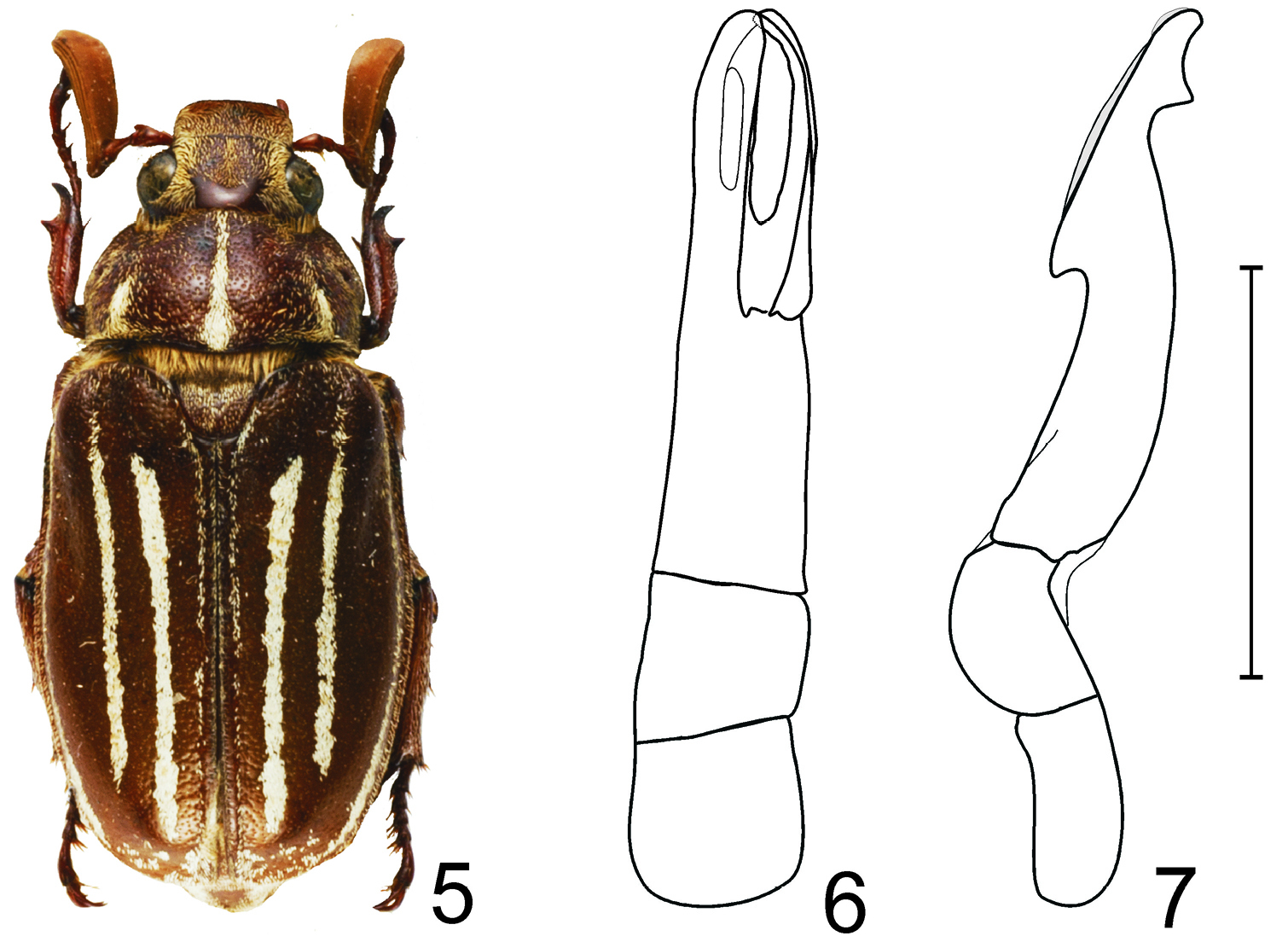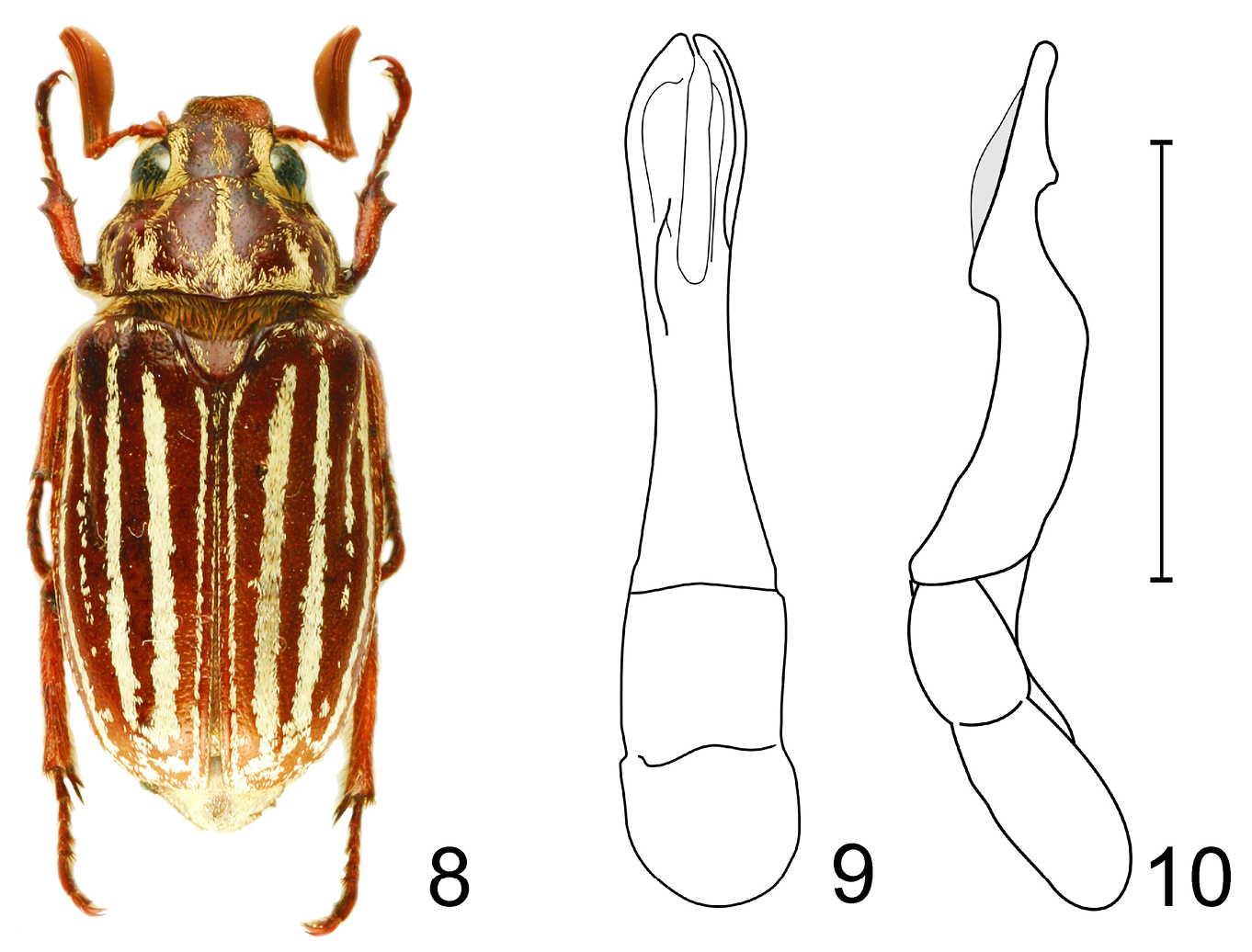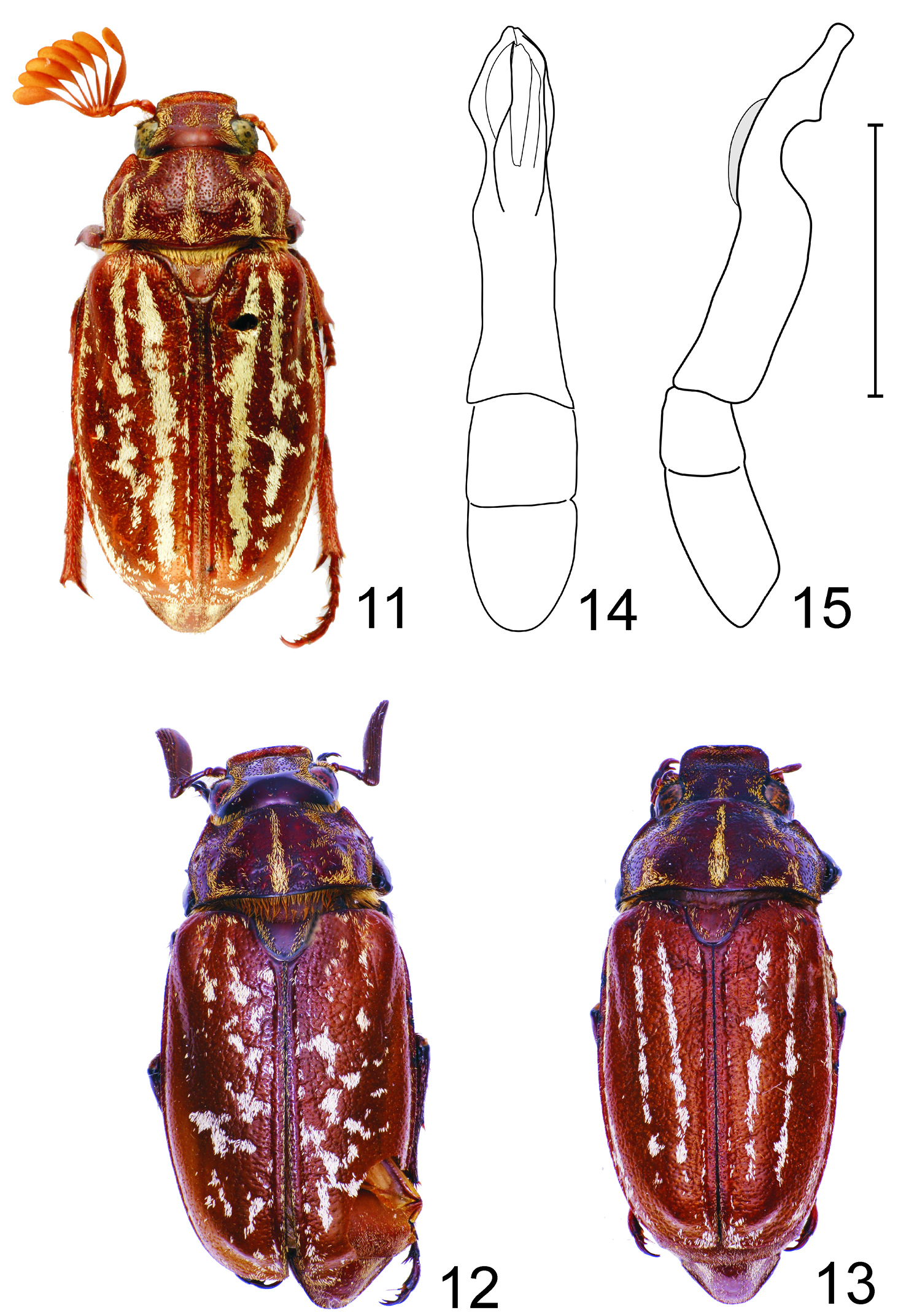(C) 2011 Richard Sehnal. This is an open access article distributed under the terms of the Creative Commons Attribution License, which permits unrestricted use, distribution, and reproduction in any medium, provided the original author and source are credited.
For reference, use of the paginated PDF or printed version of this article is recommended.
A review of Polyphylla Harris, 1841, species belonging to the subgenus Granida Motschulsky, 1861, from continental Asia is presented. One new species is described from Thailand: Polyphylla (Granida) simoni sp. n. Polyphylla (Granida) nikodymi de Wailly, 1993, is recorded from Thailand for the first time. Polyphylla (Granida) minor Nomura, 1977, is recorded from Yunnan (China) for the first time. The previously unknown female of Polyphylla (Granida) phongsali Zídek, 2006, is described.
new species, new locality records, Scarabaeidae, Melolonthinae, Melolonthini, Polyphylla, Granida, mainland Asia
The subgenera Granida Motschulsky, 1861, and Grananoxia Brenske, 1890, of the genus Polyphylla
Harris, 1841, form a pair of subgenera distinguished from other
Eurasian subgenera by unequal tarsal claws in males. The basal tooth of
the inner claw on the protarsus is distinctly longer than that of the
outer claw, whereas the meso- and metatarsal claws bear more robust
basal teeth on the outer claws. As far as it is known, tarsal claws in
females are equal. Members of the subgenus Grananoxia differ from Granida
species by their nearly unicolor pale brown body and entire surface of
vertex and pronotum covered with pale, long erect setae (
In the literature, the pattern of elytral sculpture
(four scaly longitudinal stripes on each elytron) has also been used as a
suitable delimiting character of the subgenus Granida (e.g.,
Eight species of the subgenus Granida are currently recognized.
Recently, the authors had the opportunity to study several specimens of the subgenus Granida collected by Czech entomologists in China, Laos and Thailand. Examination of this material allowed us to describe one new species, to describe previously unknown female of Polyphylla (Granida) phongsali, and to define the geographic distribution of Polyphylla (Granida) nikodymi and Polyphylla (Granida) minor.
Since the previously known continental Asian Polyphylla (Granida) species were described recently and their descriptions are rather detailed, the authors have decided to mention only the important diagnostic characters of these species.
Material and methodsThe following abbreviations (after
ABCC Czech Republic, České Budějovice, Aleš Bezděk collection;
BMNH United Kingdom, London, Natural History Museum (Malcolm Kerley, Maxwell Barclay);
DKCC France, Chartres, Denis Keith collection;
JZCP Czech Republic, Praha, Jiří Zídek collection;
MNCP Czech Republic, Praha, Milan Nikodým collection;
NMPC Czech Republic, Praha, National Museum (Natural History) (Jiří Hájek);
PFHC Czech Republic, Hradec Králové, Pavel Filip collection;
PPCB Czech Republic, Brno, Petr Pacholátko collection;
RSCV Czech Republic, Velenice, Richard Sehnal collection;
Specimens of the newly described species are provided with one red printed label: “Polyphylla simoni, HOLOTYPUS [PARATYPUS], [type specimen number], ♂, R. Sehnal & A. Bezděk det. 2009”.
Exact label data are cited for type specimens. Authors’ remarks are in brackets: [p] – printed; [h] – handwritten. Labels are separated by double slash “//”.
Taxonomyurn:lsid:zoobank.org:act:5BB817CC-4399-4DED-BDE3-CFAF2DE8B6BC
http://species-id.net/wiki/Polyphylla_(Granida)_simoni
Figs 1–4“N Thailand, 100 km NE of Nan, Doi Phu Kha N.P.”.
Holotype (male), labeled: “N Thailand, 100 km NE of Nan, Doi Phu Kha N.P., 20.-25.IV.2004, Filip Pavel lgt. [p]”, in BMNH; paratypes Nos. 1–5 (all males), same data, PT Nos. 1–3 in RSCV, PT No. 4 in NMPC, PT No. 5 in PFHC.
Male, body length 22.0 mm excluding pygidium. Body elongate, moderately convex. Surface color chestnut brown, pronotum very slightly darker (Fig. 1). Dorsal surface of head, pronotum and scutellum covered with whitish to pale ochrous scales, elytra with whitish scales. Head appendages, legs (except of femora) and ventral surface of abdomen covered with short, whitish to pale ochrous setae. Pro-, meso- and metasternum as well as femora with long pale ochrous hair-like setae.
Labrum deeply bilobed with several erect setae laterally. Clypeus transverse with anterior margin considerably upturned, anterior angles broadly rounded, sides very slightly convergent posteriad; surface with coarsely, dense, laterally somewhat confluent punctures; scales denser and erect along anterior and lateral margins, posteriorly less dense and recumbent. Frontoclypeal suture present, forming an uninterrupted narrow ridge. Frons coarsely, irregularly punctured. Pale ochrous scales on frons form three stripes, medial longitudinal stripe separated from lateral stripes by coarsely punctured areas. Vertex impunctate and shiny. Canthus narrow, reaches to about half of eye width, with pale ochrous erect setae. Angle between lateral side of clypeus and canthus obtuse (in view from above). Antenna with ten antennomeres, club heptamerous, gently curved outwards, two times longer than shaft. Scapus dilated apically and covered with narrow brush of moderately long erect setae, pedicellus short and stout, about as long as wide, antennomere 3 slender, with three erect setae, as long as basal antennomeres combined. Terminal maxillary palpomere sparsely covered with short erect setae.
Pronotum transverse, convex, widest approximately at middle. Lateral margins bisinuate, anterior angles prominent with rounded apex, posterior angles obtusely angulate with somewhat upturned apex. Anterior margin thinly bordered. Basal border interrupted medially. Surface of pronotum rugged, with complex scaly pattern (Fig. 2).
Scutellum parabolic, with disc slightly impressed and impunctate, lateral sides covered with scales, apex broadly rounded.
Elytra nearly parallel-sided in basal half, rounded apically, moderately convex. Surface coarsely irregularly punctuate, covered with whitish scales forming four longitudinal stripes on each elytron plus one short longitudinal row of few isolated patches arising on humeral umbone. Longitudinal stripes with poorly defined edges. Beetle macropterous, capable of flying.
Ventral surface of thorax densely covered with long, erect setae. Abdominal sternites with dense, short, recumbent setae, anterior margin impunctate. Pygidium triangulate, broadly rounded apically, densely covered with recumbent scales, nearly impunctate and with only few isolated setae along midline.
Pro- and mesofemora densely, irregularly punctuate, with long erect setae. Setae of metafemora somewhat sparser and shorter. Protibia bidentate, covered with sparse, short, setae, terminal spur inserted against basal tooth. Meso- and metatibia very slightly expanded apically, with transversal carina medially armed with 3–4 short thick bristles. Surface of meso- and metatibia covered with sparse, short, recumbent setae, mixed with long and erect setae on inner sides. Tarsal claws with distinct basal tooth ventrally, unequal in all legs. Protarsus with distinctly longer basal tooth of inner claw, whereas meso- and metatarsi with more robust basal teeth on outer claws.
Male genitalia. Parameres fused basally for more than half of length, nearly two times longer than phallobase (Fig. 3, arcuate in lateral view, with a small ventral tooth apically (Fig. 4).
Female unknown.
Polyphylla (Granida) simoni sp. n. 1 Habitus of holotype male (length 22.0 mm), dorsal view 2 Detail of pronotum, dorsal view 3 Male genitalia, dorsal view 4 The same, right lateral view, shaded area indicates overlapping part of left paramere. Scale bar: 5 mm for Figs 3–4.
The paratypes slightly vary in body length (20.0–23.0 mm, excluding pygidium), otherwise they are very similar to the holotype.
The species is named in honor of Šimon, son of the first author.
All specimens were collected at light.
NE Thailand (Fig. 20).
This species belongs to a group of Granida species with well-defined scaly stripes on the elytra. Polyphylla (Granida) albolineata, Polyphylla (Granida) schoenfeldti and Polyphylla (Granida) taiwana are rather large (27–32 mm) and with unidentate protibia in males. Polyphylla (Granida) simoni sp. n. is thus similar mainly to Polyphylla (Granida) nikodymi from mainland Asia and Polyphylla (Granida) minor from Taiwan and China. These species are easily separated by the shape of the male genitalia. Parameres bear a small tooth subapically in Polyphylla (Granida) simoni sp. n. (see in the lateral view), while this small tooth is located much more basally in Polyphylla (Granida) nikodymi and Polyphylla (Granida) minor (compare Fig. 4 and Fig. 7). Moreover, the antennomere 3 is long and slender and more than three times longer than antennomere 2 in Polyphylla (Granida) simoni, while it is rather stout and twice as long as antennomere 2 in Polyphylla (Granida) nikodymi and Polyphylla (Granida) minor.
http://species-id.net/wiki/Polyphylla_(Granida)_minor
Figs 5–7“Wushe, Hotso, Taiwan”.
Formosa (Tchaj-wan), Nantou, Wushe, 1.6.-6.6.2002, Jar. Dalihod leg., 1 male in RSCV; Formosa (Tchaj-wan), Nantou, Wushe, 4.6.-6.6.2004, Jar. Dalihod leg., Jana Dalihodová Baštová leg., 2 males in RSCV; China, Yunnan prov., Kunming – Xishan, 19. 5. 1993, L. Bocák lgt., 1 male in PPCB.
Polyphylla (Granida) minor and Polyphylla (Granida) nikodymi share similar shape of antennomere 3 (rather short, only twice as long as antennomere 2 and with distinct anterodistal tooth). These species are easily separated by the shape of the male genitalia Figs 6–7 and Figs 9–10) and by the scaly pattern on pygidium (the pygidium is impunctate and bare along midline in Polyphylla (Granida) minor, while it is entirely covered with recumbent scales in Polyphylla (Granida) nikodymi).
Polyphylla (Granida) minor 5 Habitus of male (Yunnan, China, length 19.5 mm), dorsal view 6 Male genitalia, dorsal view 7 The same, right lateral view, shaded area indicates overlapping part of left paramere. Scale bar: 5 mm for Figs 6–7.
Taiwan. Recorded from Yunnan province of China for the first time.
The specimen from Yunnan slightly differs from those from Taiwan by the shape of whitish scales on pronotum and elytra that are slightly broader. No relevant differences were found in the shape of male genitalia. If these morphologic characters were constant in other specimens coming from the same area, it would be reasonable to assume a subspecific status of the population from Yunnan. However, the material available is insufficient to decide whether such differences fall within the intersubspecific variability.
Although we were not able to study type material of Polyphylla (Granida) minor, all three males from Taiwan examined by us were collected from the type locality of this species.
http://species-id.net/wiki/Polyphylla_(Granida)_nikodymi
Figs 8–10“Birmanie, Süd-Ost”.
Paratype (male), labeled: “Birmanie, Süd-Ost, 10.V.1990 [h] // PARATYPUS [p, red label] // Polyphylla (Granida) nikodymi De Wailly 1994 [h, red label]”, in NMPC; paratype (male), labeled: “Birmanie, Süd-Ost, 10.V.1990 [h] // PARATYPUS [p, red label]”, in PPCB.
THAILAND NE, Loei prov., Phu Rua N.P. 1100m, 17˚30′N, 101˚21′E, 6.-9.iv.1999, D. Hauck leg., 1 male in PPCB.
For separation from related species, see diagnosis of Polyphylla (Granida) minor. Male genitalia as in Figs 9–10.
Polyphylla (Granida) nikodymi 8 Habitus of paratype male (length 22.5 mm), dorsal view 9 Male genitalia, dorsal view 10 The same, right lateral view, shaded area indicates overlapping part of left paramere. Scale bar: 5 mm for Figs 9–10.
Southeast Myanmar, first record for Thailand.
Each specimen from the type series bears only a vague handwritten locality label “Birmanie, Süd-Ost”. Thus, the specimen from NE Thailand is the first specimen with exact locality data and it is the first record of this species for Thailand.
Paratypes of Polyphylla (Granida) nikodymi are deposited in PPCB and NMPC (see also
http://species-id.net/wiki/Polyphylla_(Granida)_jessopi
Figs 11–15“China, Foochow”.
Holotype (male), labeled: “CHINA, Foochow [p], vi. 1936 [h], M. S. Yang [p, white label] // next to Polyphylla nov. sp. [h] Ph. de Wailly det [p] // Pres. by Com. Ins. Ent. B. M. 1948–152 [p] // TYPE [h, red label]”, aedeagus is glued on label separately pinned: “CHINA, Foochow, KIENG, vi. 1936, M. S. Yang [h] // Brit. Mus. 1948–152 [h] // next to Polyphylla nov. sp. [h] Ph. de Wailly det [p]”, in BMNH.
CHINE Guangxi / Da Yao Shan / V. VI. 2008 / SINIAEV leg., 2 males and 1 female in DKCP.
Scaly stripes on the elytra are partially fragmented (Figs 11, 13), rarely the elytra are completely maculate (Fig. 12). Antennomere 3 long and slender, three times longer than antennomere 2. Basal margin of pronotum convex medially. Male genitalia as in Figs 14–15.
Polyphylla (Granida) jessopi 11 Habitus of holotype male (length 19.0 mm), dorsal view 12 Habitus of male (Guangxi, China, length 20.0 mm), dorsal view 13 Habitus of female (Guangxi, China, length 18.0 mm), dorsal view 14 Male genitalia, dorsal view 15 The same, right lateral view, shaded area indicates overlapping part of left paramere. Scale bar: 5 mm for Figs 14–15.
Fukien and Guangxi provinces of China.
For a long time, Polyphylla (Granida) jessopi was known from single male only. Recently,
http://species-id.net/wiki/Polyphylla_(Granida)_phongsali
Figs 16–19“N. Laos, Phongsali, Gnoi-ou”.
Holotype (male), labeled: “N. Laos, Phongsali, Gnoi-ou, Li Jingke VI-2003 [h] // BMNH (E) 2006–162 [h] // J. ZIDEK det. 2006 [p] Polyphylla phongsali Zídek [h] HOLOTYPE [p, red label]”, in BMNH.
LAO-NE, Hua Phan prov., ~20˚12′N, 104˚01′E, PHU PHAN Mt. 1500–1900m, 17.v.-31.vi. 2007, M. Brancucci leg., 1 male in ABCC; LAOS-NE, Houa Phan prov., 20˚13′09-19″N, 103˚59′54″-104˚00′03″E, 1480–1510m, PHOU PHANE Mt., 22.iv.-14.v.2008, Vít Kubáň leg., 1 male and 1 female in NMPC; LAOS-NE, Houa Phan prov., 20˚13′N 103˚59′E, Ban SALUEI village, 16.vi.2009, 1350 m, at light, Vít. Kubáň leg., 1 male in NMPC; LAOS-NE, Houa Phan prov., 20˚12-13.5′N 103˚59.5′-104˚01′E, Ban Saluei → Phou Pane Mt., 1340–1870 m, 1.v.-16.vi. 2009, Lao collectors leg., 1 male in NMPC; Laos, Houaphan prov., 38 km S of Sam Neua, Saluei 9.-22.5.2009, Martinů lgt. 1350–1900 m, 1 male in JZCP and 1 male in RSCV; Laos, Houaphan prov., 38 km S of Sam Neua, Saluei 9.-22.5.2009, Bednařík lgt. 1350–1900 m, 1 male in RSCV.
(Fig. 17). Similar to male (Fig. 16), with the following exceptions. The length of the only known female specimen is 28.0 mm (except of pygidium), while the length of males varies between 21.5–24.5 mm. Anterior margin of clypeus only very feebly upturned, nearly flat. Antennal club pentamerous. Outer margin of anterior tibia distinctly tridentate. Upper apical spur of metatibia broad, flattened, blunt apically. Tarsal claws of all pairs of legs equal in length.
Polyphylla (Granida) phongsali 16 Habitus of male (Hua Phan, Laos, length 22.5 mm), dorsal view 17 Habitus of female (Hua Phan, Laos, length 28.0 mm), dorsal view 18 Male genitalia, dorsal view 19 The same, right lateral view, shaded area indicates overlapping part of left paramere. Scale bar: 5 mm for Figs 18–19.
The female specimen was collected at light.
An easily recognizable Polyphylla (Granida) species because of its maculate elytra. Antennomere 3 long and slender, more than three times longer than antennomere 2. Basal margin of pronotum is almost straight against the scutellum, while convex in other Granida species. It is most likely to be confused only with some Polyphylla (Granida) jessopi specimens bearing the same maculate elytral pattern. Polyphylla (Granida) phongsali in average larger than Polyphylla (Granida) jessopi (the length of males varies between 21.5–24.5 mm versus 18.5–20.0 mm in Polyphylla (Granida) jessopi). Male genitalia as in Figs 18–19.
Northern Laos.
The species was originally described from a single male. Here we recorded eight additional specimens from northern Laos (Fig. 20). The specimens with altitude data were collected between 1350–1900 m a.s.l.
Distribution of Polyphylla (Granida) species in continental Asia. Because of imprecise locality data, distributional mark of Polyphylla (Granida) nikodymi in Myanmar is omitted.
The authors are very grateful to all curators and colleagues who enabled us to study the specimens in their collections. Blaine A. Mathison (Atlanta, USA) kindly improved our English. We are also thankful for the comments of two anonymous referees who helped to improve the manuscript. The second author was partially supported by Synthesys project GB-TAF-4124.












